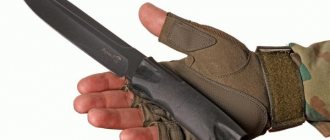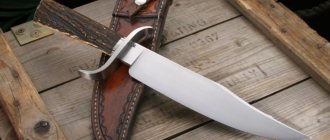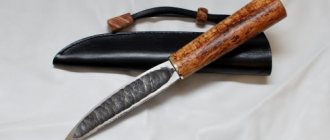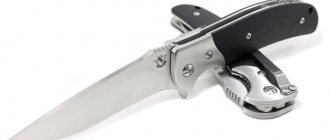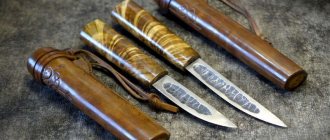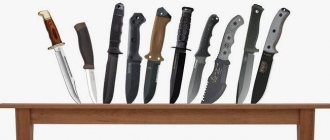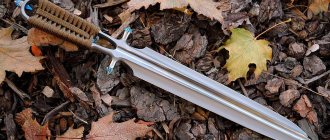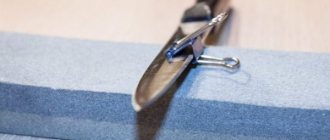Puukko knife - what is it?
Any resident of Russia has heard about the Finnish woman. But few people are familiar with the Scandinavian word puukko. Nevertheless, it denotes that Finnish knife which, despite its danger, has acquired a kind of romantic fame.
In essence, a finka is a small, non-folding knife, equipped with a wooden handle. Its blade is somewhat shorter than the handle (up to 15 cm), the butt is quite large, and the handle is usually round. The blade has a straight shape, made of steel, the bevel of the blade is small. There is no limiter, which is a “proprietary” feature of this model.
Wood is traditionally used to create the handle. Birch is best suited. Craftsmen make excellent Finnish-type knives with handles made of birch burl, which is very durable and at the same time has an impressive texture. Small size, narrowed blade, ease of grip in the palm of such a knife - these are the distinctive features of the Finnish knife. Finnish knives are different, including the pommel of the handle.
The advantages are that it is multifunctional and durable. It is used to cut everything from bread to branches. This is not just a knife, but a universal tool. Hunters used puukko everywhere - they shaved with a knife, butchered game, repaired hunting equipment, and, if necessary, could make a hole in the ice. In addition, the durability of this weapon is very high. If it is made according to all the rules, conscientiously, the handle will not crack, even if you hit the butt with a hammer. A straight blade will not break under very heavy loads.
Puukko it is. Puukko (Finnish)
Traditional puukko
Puukko
(Finnish puukko, [ˈpuːkːo] from
puu
- wood) is a traditional Northern European, mainly Finnish form of knife. One of the main types of universal non-folding knives.
Etymology
Puukko was originally called veitsi in Finnish, which means simply “knife”. The word puukko began to be used to distinguish the national knife from other types of knives. Literally, “puukko” means “knife with a wooden handle” (“puu” means “wood” in Finnish).
According to another theory, the word puukko comes from the German knife pook
, with which German merchants supplied the northern regions of Sweden. From Swedish-speaking settlements, the changed name of the knife could have entered the Finnish-speaking environment.
From the word “puukko” in Finnish the verb puukottaa is derived - to stab, wound or kill with a knife and the specific word puukkojunkkari - a hooligan, a young man armed with a knife.
Characteristics of puukko
Some types of puukko handle heads: 1. barrel-shaped handle with a metal frame; 2. head with comb; 3. head “fungus”; 4. head with a bend; 5. head with a figurative image of a horse's head.
The blade is straight, short in length, usually shorter than the handle, 60-100 mm, with a relatively thick spine. Wedge-shaped in cross-section, sometimes with valleys. The slopes of the blade are usually relatively low, the cutting edge is formed by slopes, without approaches. The back of the blade is straight or slightly sloping (“drop point”), on some models there is a “pike” - a bevel of the butt, some hunting skinning varieties have a slightly raised line of the butt (“trailing point”). The handle is traditionally made of wood, most often birch is used, including Karelian. Usually there are no pronounced sub-finger stops or guard. The head of the handle traditionally has a bend, or a “fungus” for ease of removing the knife from the sheath; sometimes a kind of ridge is placed on the head to determine the spatial orientation of the blade by touch; in some varieties the head is decorated with a three-dimensional image of an animal made of a copper alloy, most often the head of a horse. The sheath is made of leather or wicker from birch bark. The sheath design may include a wooden insert for the blade. The knife is deeply recessed in the sheath and is held in it due to friction between the sheath and the handle. Structurally, the sheath can either consist of two flat parts fastened to each other, resembling the silhouette of a fish with fins, or be rolled up into a tube from one sheet. Often the scabbard has a metal device. The suspension is either waist (on a belt) or neck. In the latter case, a sheath with a lid that completely covers the handle is often used.
Origin and history of puukko
Modern puukko "Ahti Tikka", made by the Finnish company Kivikangas
The form of the puukko dates back to the pre-Iron era; bronze and bone tools found in Scandinavia are practically no different in design from modern steel knives. In the 10th-12th centuries, knives related to puukko were traditional throughout northern Europe, including the European territory of Russia.
Finnish knife – rich history
Finca was invented on the Scandinavian Peninsula. Its first creators were the Finns themselves, hence the name. However, there is another version of the origin. Some researchers believe that such knives were originally brought to Scandinavia from German lands, and after they spread in Sweden they passed to the Finns and became incredibly popular. Whether this is true or not is difficult to say. However, the fact that the Scandinavians highly valued the Finnish woman is undeniable.
Historians say: prototypes of Finnish women can be found in Old Scandinavian burials. Small knives have long been popular among hunters. After all, the puukko is small in size and extremely convenient. It was these advantages that made him in demand.
At the beginning of the 20th century, the Finnish dog appeared in Russia. This happened even before the revolution. The Russian Empire had plenty of hunters, connoisseurs of edged weapons, and criminal elements. By the way, it was these latter who were the first to appreciate the new type of knife. It turned out to be convenient to hide the puukko behind the top of the boot, behind the waist belt. The rest of the population also quickly realized all the advantages of a convenient Finnish knife, renaming it Finnish.
Russian gunsmiths adopted the technique of manufacturing a new product; production was quickly established and even improved. The original puukko has a smooth blade and does not have a guard. In Russia, the knife began to look a little different. They began running a fuller along the blade, equipped it with a palm rest, and the butt, although it remained thick, began to look more beveled. However, the popularity of the Finnish puukko turned out to be so incredible that any small knife with a straight blade and a round handle began to be called a “finka” (even if it was a weapon of a completely different type).
Finnish became especially popular after the revolution. Criminals of all stripes considered it an obligation to purchase a detailed blade. It is invisible when worn, and the Finnish grip of the knife makes it indispensable in a fight. The fighting properties of the puukko brought him criminal fame. It got to the point that in 1935 the Finn was outlawed as a prohibited weapon. However, tough measures from the Criminal Code only increased its value. Anyone who dared to wear a finca automatically became authoritative among criminals.
When the Soviet-Finnish war began, the advantages of puukko were noted by the military. They noticed how functional the Finnish car is in the hands of the Scandinavians. It was decided to start producing Finnish knives for auxiliary weapons of Soviet soldiers. Subsequently, the weapon was called the “scout knife.”
But even earlier, in 1935, in the Nizhny Novgorod region they began to produce fins for employees of the People's Commissariat of Internal Affairs. Today, weapons experts know the NKVD Finnish knife. This is the famous NKVD puukko with which the security officers were armed. It was equipped with workers of various convoy units, operational and special departments, and heads of correctional camps. We can say that the Finn, which was originally a tool for hunters, later became an indispensable tool in the criminal world - on both sides. Finnish knives were used by both those who broke the law and those who protected it.
Finnish knife "puukko". History, features, opinions
A knife is not only a murder weapon, but also a tool for everyday work. The only pity is that now many manufacturers are moving away from this concept, creating huge human cutters that are impossible (or not advisable) to use in any other way. However, there are still so-called “national knives” that are truly universal. You can kill someone with them, and it’s quite possible to create something useful around the house. And today we will talk about the Finnish knife , which is just that.
Story
It is necessary to immediately clarify that the “ Finnish knife ” and the “Finnish knife” are completely different knives. Yes, there is some continuity, but the Finnish tasks are completely different. And the shape is quite different. But more on this a little later.
So, the Finnish knife is one of the oldest types of knives, which has practically not changed over time. In Bronze Age excavations, bone and metal samples are found that are practically no different in shape from modern products. This is understandable - the blade is as simple as possible, without technical frills, but it performs its task perfectly. Moreover, it was precisely this form of knife that later became established throughout Northern Europe and parts of Russia. And it not only gained a foothold, but also became the basis for its own “developments” - the notorious Finnish woman is an excellent confirmation of this. And when developing the “Scout Knife” HP-40, it was the Finnish knife .
In its homeland, by the way, it is called puukko , which translated means “knife with a wooden handle.” And I won’t even begin to list how many specific varieties of this knife there are. Each also has its own name, depending on its purpose, locality of manufacture, and the characteristics of its shape. And this, of course, is interesting, but it’s not the point. But it is important that a simple Finnish knife has enormous potential and the possibility of modernization. Which, in fact, is what modern masters are actively doing.
But the Finnish knife is, first and foremost, a tool for everyday use. And the people, especially among the indigenous population, prefer the simplest varieties with some “professional” modifications. For example, in models used by hunters for skinning, there may be a rise in the butt - the so-called “ Trailing point” , and sometimes a gutting hook. This model is called Nylkypuukko . Finnish knives were so widespread that in 1977 a law was passed prohibiting the carrying of puukko within city limits. In other places - please wear it and use it for your health - this is a tool, not a murder weapon. By the way, most Finnish knives do not fit into the category of “edged weapons”.
Peculiarities
The Finnish knife is as simple as possible. A straight, short (10 cm shorter than the handle) blade, with a straight back and a rather thick spine (up to 5 mm). The cutting edge is without leads, formed by slopes. The cross-section is wedge-shaped, there are no structural tricks. Options with fullers, drop points and bevels are typical only for specialized hunting varieties or for remakes, which are actively influenced by modern trends in “knife construction”.
The handle is straight, uniform, without finger rests. It may be slightly shorter than the average male palm, which is why a specific “Finnish grip” was created, which is also called “diagonal”. The handle rests on the palm and is held by three fingers, and the other two are held at the other end of the handle. If you hold it tightly, your fingers will not slip onto the blade. But this grip takes some getting used to. Effective retention is also facilitated by the structure of the handle material - burl or Karelian birch (extremely rarely - bone), richly impregnated with wax. Wax not only protects the wood from rotting and moisture, but also prevents fingers from slipping, causing slight “sticking”.
The handle of a Finnish knife is most often ordinary, barrel-shaped. Possibly with a metal frame. In some cases, with a bend or a figured image that helps determine the orientation of the blade by touch. At the same time, the end should still rest against the palm, so large-scale and complex designs are not welcome.
The scabbard is a simple leather one, possibly with a wooden liner. The blade sinks completely, the handle partially. Here, by the way, the bend at the end turns out to be useful, which makes it easier to remove. Belt or neck suspension.
Opinions
Basic knife. Simple, versatile, convenient. Many people begin to master the skill of using knives with some version of puukko. Even the debates are more about beauty than about convenience. People discuss the quality, material and shape of the handle, the pattern on the blade, the design features of the sheath, but not how comfortable this blade is. Because in principle there should be no complaints against him. Of course, if you want something more complex and specialized, then it is better to switch to other blades equipped with the appropriate design features. But here everything depends on personal wishes.
And the efficiency of the Finnish knife is high. Otherwise, criminal elements, for whom the main criterion is maximum simplicity, convenience and invisibility, would not have started to use Finnish devices so widely.
Speaking of Finns. It all started at the beginning of the twentieth century, during the Soviet-Finnish wars. Let's not argue about the legitimacy and who won how, let's just say that the Red Army soldiers were very surprised by how effectively the Finnish fighters used their puukko . And, of course, they wanted such knives for themselves. But you still need to get used to the Finnish grip, so I had to modernize the model for personal convenience.
Types of Finnish women
Finnish knives today are very diverse. We are accustomed to mean by the concept of a “Fink knife” any weapon of a small size, with a straight, comfortable blade and a handle enlarged in relation to it. However, there are two main types of such knives:
- puukko;
- leuku.
It should be noted that puukko and leuku have certain differences. What a classic puukko looks like has already been discussed above. But the leuku differs in that its blade is larger than its handle. In addition, the top of the handle itself is designed in the leuku in the form of a kind of fungus - it expands at the end. Scandinavians usually use this knife when they need to arrange a campsite - chop wood chips for lighting a fire, trim pegs for a tent and tent ropes. It is for this reason that the leuku is commonly called a bivouac knife. It does not have a guard, and the fungus at the end of the handle performs a specific function - it prevents the hand from slipping when a person chops something in a sweeping manner.
In addition, traditional fincas are classified according to their purpose and place of manufacture. The fact is that in different areas of old Finland, knives were produced individually. And in every region they tried to give their products uniqueness and distinctive features. Here are just a few options:
- Pekanpää;
- Rautalampi;
- Kauhava;
- Kalajokilaakso;
- Toijala.
According to their purpose, finks can be divided into knives:
- everyday;
- soldiers;
- hunting
Today in Finland there are a number of factories producing puukko and its varieties. In addition, there are many homemade products, including miniature ones. In Russia they even produce folding blades, although the classic Finnish knife has never been like that. All this diversity only emphasizes the advantages of puukko.
Finnish puukko knife: drawing, how to make it yourself
Before starting the process of making a Finnish puukko knife, make a drawing of a universal blade on paper. If a steel part is made with a length of 95 mm plus 5 mm for the base, then its width is 23 mm.
The descents of the blade begin from the middle of this distance. The shank is made slightly larger than the handle, that is, from 120 mm. It should have notches and a sharp pin at the threaded end. It is also necessary to machine a stop sleeve 3-4 mm thick and a butt plate from brass.
Puukko knife drawing
They make puukkos with their own hands like this:
- The paper blank is attached to a sheet of steel and a blade with a shank is cut out with a grinder.
- On the cutting part, a caliper is used to mark and descents are made, using a grinder or a grindstone for the last step.
- The blade is ground and polished.
- At the next stage, it should be hardened in a forge, the metal should be tempered, the workpiece should be washed from oil, and polished with fine-grained sandpaper.
- A round sleeve is machined from brass, the width of which is equal to the thickness of the handle at the junction.
- A hole is made in the resulting limiter corresponding to the size of the widest part of the shank.
- The back plate is formed from brass.
- A hole is drilled in it according to the thickness of the tip of the shank, which has a thread.
- A block is cut out of wood; its length should be the same as the handle.
- A hole is made in the center for the shank, corresponding to its width.
- A brass stopper sleeve is placed on the shank.
- Glue is poured into the hole of the handle blank, and it is connected to the blade.
- Then the backplate is attached using, among other things, an adhesive composition.
- The structure must be clamped with clamps to dry for 1-2 days.
- The shank pin protruding from the handle blank is covered with a cap nut.
- The wood is turned on a machine to give the handle the desired shape and thickness.
- The wooden part is sanded and polished until smooth.
- Finally, the handle is impregnated with linseed oil or beeswax.
Example of how to make a puukko with your own hands
1 of 5
Making a Finnish knife
Initially, puukko were made in a handicraft way. Despite the fact that the predominant material for creating knives was wood, some craftsmen created finks with bone handles. The handle of the puukko was never assembled; it was made from a single piece of material. Therefore, the blade was attached exclusively using the mounted method. The shank was made rectangular, and to prevent it from spinning inside the handle, special cuts were made on it.
In 1830, in western Finland, workers at the Fiskars blacksmith shop began making Finnish knives for sale. A few years later, this company became one of the most famous companies that produced fincas industrially. Half a century later, it appeared, and then other Finnish knife companies began to emerge. Puukko were not offered separately, but with a sheath. The covers were not necessarily made from leather; they were often made from birch bark. Craftsmen of the 19th century usually painted the scabbard with red paint, and for color they decorated it with black stripes.
The classic version of the Finnish puukko knife is always created with a small blade that has a one-sided sharpening. Such a blade should ideally be only 20 mm wide and 125 mm long. The thickness of the knife reaches 4 mm. Particular importance is attached to the butt. It is created moderately thick to give the handle increased strength.
In the old days, Finnish craftsmen created puukko at home from old braids. Scythe steel was excellent for cold forging. Today, high-carbon steel is used to produce Finnish knives. The better the metal, the better - such a blade will require sharpening less often and will retain its sharpness for a long time.
Today you can make puukko with your own hands. Suitable steel can be found at a power tool store. The most affordable option is a saw that can cut metal. A ready-made cardboard template is applied to its canvas, and then all that remains is to grind the metal on all sides according to the pattern applied to it. The cuts are carefully made on an emery machine, followed by the grinding and polishing stage. A sleeve is made of brass, which must be soldered to the shank. The handle is turned and drilled using a lathe. To ensure that the shank holds firmly in the handle, its fastening is reinforced with glue.
Today you can find many such artisanal finches. However, the easiest way is to purchase a Finnish knife in a specialized store. After all, not only classic puukkos are sold here, but also original handmade knives. For example, in Kizlyar, world-famous blades are produced, including Finnish ones.
Finnish puukko knife: description
The traditional Finnish puukko knife has the following characteristics:
- universal blade 10-15 cm with a straight spine, without fullers;
- a wooden barrel-shaped handle with a smooth surface, which is smaller in size than the cutting part;
- forged bolster separating the blade from the handle;
- a small back, which can be in the shape of a mushroom, in the shape of a dog’s head, slightly lowered or rounded.
Initially, it was a household and hunting knife, made from steel that was at hand at the blacksmith. But the Finns had to use the weapon in the struggle for independence, first from Sweden, then from Russia, in the war with the USSR. In the Union, other versions of the puukko were created - the bandit finka and the Finnish army knife.
We recommend reading the article about a knife for cutting elk. From it you will learn about the pros and cons of short and long knives for cutting elk and wild boar, how much hunting knives for cutting elk cost and whether it is possible to use a Swedish knife for this. And here is more information about the signs and characteristic features of a scout knife.
Dimensions of a real knife
Traditional dimensions of a real puukko knife:
- blade 10-15 cm long, the most common size is 12-13 cm;
- its width is 2-2.5 cm;
- handle 11.5-13 cm long;
- its width in the most voluminous place is 3-3.2 cm;
- handle top – 1 cm.
The blade has a straight spine; the slopes to the blade should be of the Scandinavian type. For its manufacture, powder, Damascus, and carbon steel are used.
Puukko knife drawing
The barrel-shaped handle is made of wood, usually birch, and impregnated with oil. It is separated from the blade by a forged bolster. The pommel of the handle can be in several versions:
- slightly bent down;
- blunt with metal frame;
- with a convex “ridge”;
- with the outline of a mushroom cap;
- with the image of a dog's head.
The puukko also has a sheath made of leather or birch bark. In the first option, there is a wooden cover that protects the main material from damage.
The best Puukko models
The sheath is quite long, so that a significant part of the handle is hidden in it. They are also dense, narrow, and the knife is held in them due to this quality. The scabbard has a suspension that allows you to attach the weapon to your belt.
Origin and history of the old hunting knife
The oldest puukko hunting knives were made of stone or bronze, that is, they existed from a time when man had no idea about iron. But not all historians agree with this version; some believe that the guns appeared only in the 18th century. More precisely, they stood out from the general mass of household knives. For the first time this happened in the province of South Pohjanmaa. And back in the 10th-12th centuries, tools much like the puukko were used throughout northern Europe.
The name puukko can have two origins - from the word “tree” (puu), or the name of the German knife – pook. The latter were sold in Sweden and Finland by German merchants.
Puukko gained popularity during the years of the beginning of the national liberation movement in the country. Knives had the status of household knives, being excellent hunting and edged weapons. Therefore, the authorities of Sweden and then Russia could not prohibit the Finns from wearing them. During this period, puukkos begin to be made from high-quality steel, with a stacked handle.
Thanks to their versatility, the guns become popular as hunting tools outside of Finland, eventually becoming one of its brands. They were even made for the Russian imperial court. The supplier was master Lisakki Järvenpää.

